A Filmmaker's Guide to the Horror Techniques Used in 'The Exorcism of Emily Rose'
Study, Experience, and Analysis
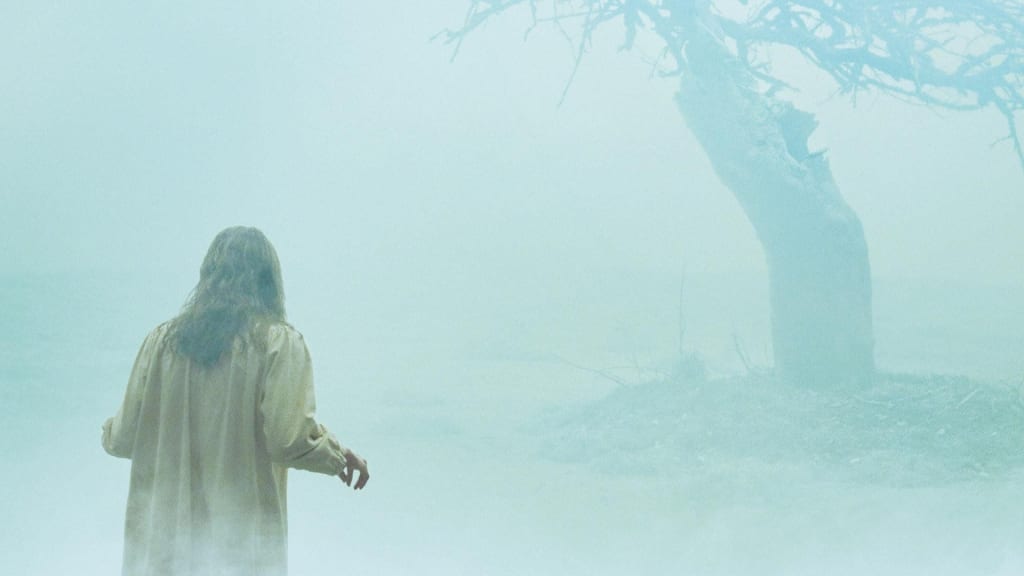
(This article will use The Exorcism of Emily Rose extensively in analysis of technique and frame. In order to get the best insight, it is recommended that you watch the whole film at least once).
The Exorcism of Emily Rose is an incredible and heartbreaking story based on the real exorcism of Anneliese Michel. As a series of weird and frightening events haunt a well-rounded young woman, we are forced to empathise with the main character and her ability to endure. The film centres on the trial that happens after she dies. Apart from being a visually stunning film, at its core is this highly important heartbreaking story of a young girl's death from an unknown cause.
We're going to focus on five main themes when looking at this film. These are:
- Atmosphere
- Normality vs. Abnormality
- Threat
- Religion
- Empathy
1. Atmosphere
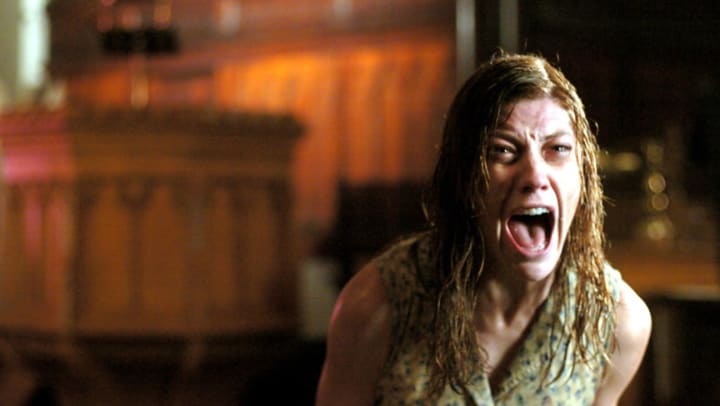
Still from The Exorcism of Emily Rose
Atmosphere in a film like this is very important. This film obviously works off the legacy of The Exorcist and tries its best to gain the same glowing atmosphere in the modern day. In The Exorcism of Emily Rose, there are many occasions in which we see the strange and ominous orange glow that is almost like fire.
In this frame, we can see that same orange glow in the background, this suggests that there is a light source and tells us where it is coming from. Not only that, but the light source being that far behind the character means that the audience get to see where she is standing and exactly where she is without lighting up the set so much that they lose the atmosphere of darkness.
Here's a tip: don't use a strobe or a spotlight, they are too concentrated. Instead, you may want to use lots of candles if you're pushed for budget. It creates a similar effect and seems a lot more realistic in creating that orange-ish glow as we see here.
Notice as we get nearer to the character, the scene gets darker. This is the effect of that light source; it lights up very particular things and leaves other things in the dark. The effect of this is to make the character stand out more and keep them out of the main light source. The atmosphere surrounding the character is therefore the effect of darkness and not the light. If you were to move the character into the lightness, you would lose the atmosphere.
The placement of character and darkness are very, very important in shots so make sure you don't waste a moment expressing it.
Let's have a look at how this is expressed in another shot we see in the film:
Frame 2
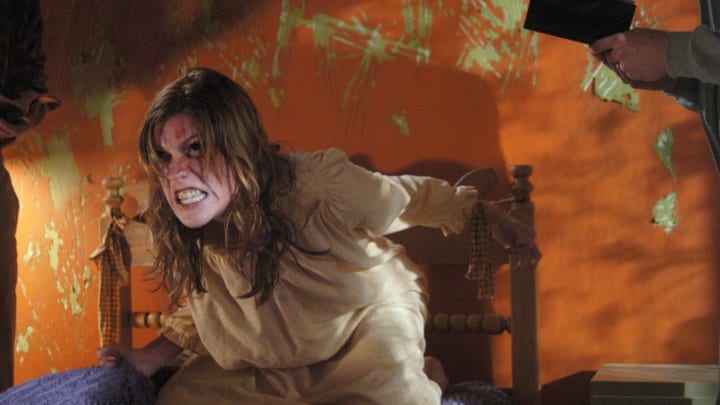
Still from The Exorcism of Emily Rose
We have the exact same effect being achieved, and we can also see that the shot tries to imitate those of The Exorcist as we have the light colours on the character and the priest standing in complete darkness. The effect of the colours on the wall give us that ominous glow again and we have those shadows which tell us where a possible light source is.
2. Normality vs. Abnormality
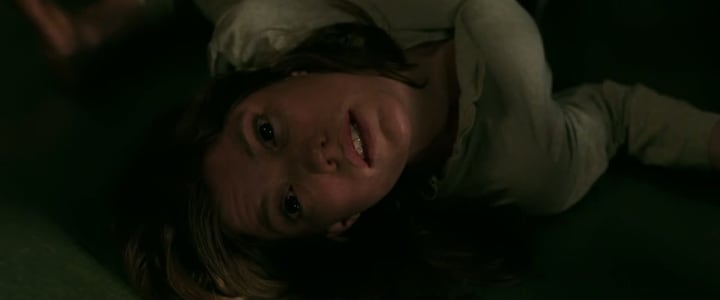
Still from The Exorcism of Emily Rose
Normality turning to abnormality is a big theme in the build up section of The Exorcism of Emily Rose as it shows us exactly what is happening to the main character. In various frames we see non-threatening situations turning incredibly threatening as black liquid pours from people's eyes and, in this frame especially, the irregular and impossible contortion of the main character's body.
We see this strange contortion as a result of whatever is happening to her as this must be done during the build-up section. Doing this straight away in the introduction may not be clear to the audience and therefore, anything afterwards will have to be pieced together with this in order to establish what's going on.
The darkness in this frame restricts us from knowing what's actually going on and therefore, we don't see the full extent of the contortion. It is important that in a horror film we have this darkness so that we can do two things:
- establish depth
- leave something to the imagination
Abnormality is a big theme in a lot of horror films, but for a film to do it so outright without a single physical entity hasn't been seen since The Exorcist and, in this case, is highly successful.
Let's have a look at another frame in which abnormality is created in the film:
Frame 2

Still from The Exorcism of Emily Rose
Have a look at the way in which light clothing is used in this scene to contrast the shadowing. The feeling of abnormality is here because in horror film, we're used to darkened clothing and slightly lighter sets. But in this scene it is the other way around. This exemplifies the feeling of abnormality and gives the build up to this scene something to look out for.
3. Threat

Still from The Exorcism of Emily Rose
Threat has always been a huge theme in horror, but in this case, we can see that threat is more directed. If you were to watch a film like Final Destination 3, you will see that threat is made to travel in all directions to each character that was on the roller coaster at that particular time. But, in The Exorcism of Emily Rose it is made clear that the threat is directed towards one character and only that particular character.
Looking at this frame, you can possibly see how threat is mainly portrayed. Not only through the movement of the character but also through the way in which the movement suggests things. The main thing the movement suggests is that the character is not moving, but being moved. The movement is a cause of something either pulling or pushing the character and the way in which the light source casts the shadow behind them exemplifies this as it lights the character up, leaving most other things in the dark.
The way in which the frame is shot also suggests how the character is under threat. Notice how there is another person in the scene but they are not in frame. This is because this scene contains the main threat and that character who is not in frame is not experiencing that threat. Since this is building up to the main exorcism in the barn etc. it is important to heighten the fact that it is only the main character that is experiencing this threat and so, they are the only ones in frame.
Let's have a look at a slightly different frame of threat:
Frame 2
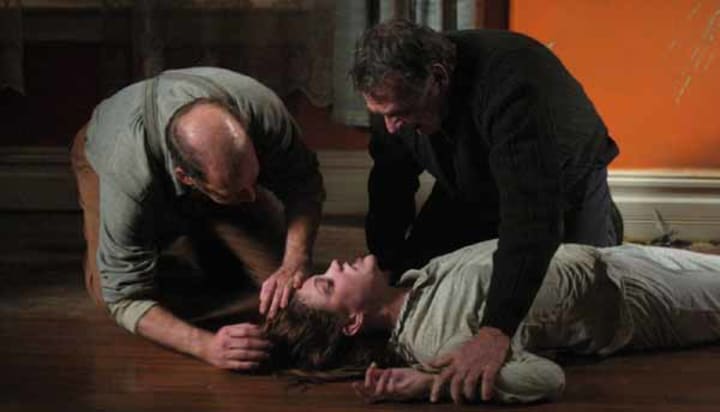
Still from The Exorcism of Emily Rose
It is clear that the threat in this frame is produced because it has now taken two other characters to restrain her. But, this isn't only it. Notice how the character on your left has his hand across her head on not on her legs, where you'd expect her to be restrained. This means that the character is probably under threat from something in their mind. It is highly suggestive along with the paleness of the characters face compared to the way they were before the strangeness began to happen.
The arms are restrained by the wrist by the character on your right. Notice how the restrained character's hands are placed. She is almost making a claw; this is suggesting that there is not only a threat to the main character but also to the characters restraining her.
4. Religion

Still from The Exorcism of Emily Rose
In this film, which is unlike a few exorcism films, the character attends a church in order to try and get help for herself. The theme of religion is not only strong because of the fact the film is about the death of a young girl who has been possessed by seven demons; but there is a sense of religious want. The main character is seen wanting help from the religious aspect and this is the main feature of religion in the film besides the exorcism.
In this frame, we see just that want of religious help. The character is seen a bit into the background and the main focus is on the altar. The main light sources are two candles in focus, the candles planted in the scene and the little lamps near the top of the frame which is just enough to see the other features of the church with the light source behind the character that is there for effect of seeing them.
The fact that the pews have the reddish seats and there seems to be a lot of brown colours in the scene, we get an ominous red glow from the window which makes the scene look slightly more frightening that it would be set in the middle of the day.
Let's take a look at another frame that shows the effect of religion on the film:
Frame 2

Still from The Exorcism of Emily Rose
What we see here is the religious symbolism of the placement of characters. If you look closely enough, it is clear that the filmmaker has made this scene look like a variant of the crucifixion of Jesus Christ. We have the two people either side and the one kneeling nearby. The thing that tells us that this is a scene of an exorcism is the man standing directly in front of the character, which is the priest/exorcist.
5. Empathy
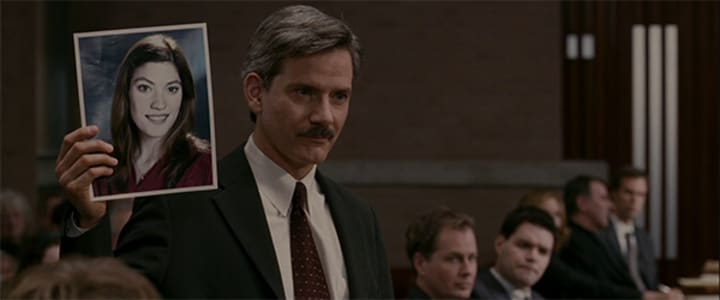
Still from The Exorcism of Emily Rose
Empathy is a huge theme in this film as, during the film, we already know that Emily has died because there is a court case going on because of her death.
The amount of empathy towards the main character comes from the fact that she is actually, in the present time of the film, already dead and thus, this is established as being completely true at the end of the film. The highest amount of empathy comes from the way the other characters treat the evidence, which is with great trepidation. This creates further empathy when the flashbacks to the exorcisms are played, creating an even greater fear.
Even though this isn't seen in one particular scene of the film, this frame in which we see Emily looking like a fairly normal American girl is a very important part of the film. This is the way in which many people in the courtroom remember Emily and so, everything after this becomes a shift of that normality.
If you're looking to do this then you should make completely sure that your audience know what your character actually looks like before the wounds etc. begin appearing on their body and weird things start happening. This creates that normal feeling towards the character and shifts everything from there on. It's an important way of having flashbacks that don't include much character backstory, but instead just get to the singular point.
Conclusions:
Flashbacks are very hard to achieve in horror film, but you have to remember that when dealing with a story so sensitive, you don't want to skim over any issues so make sure the details of the case are included. The main thing to note is make sure the court case deals with the case as normally as possible, any abnormalities will make the story seem unreal. And, in the case of the story actually being real, you probably don't want that to happen.
Make sure you check out the trailer for clues to how to achieve such a great atmosphere:
Good luck on your next project!
About the Creator
Annie Kapur
200K+ Reads on Vocal.
English Lecturer
🎓Literature & Writing (B.A)
🎓Film & Writing (M.A)
🎓Secondary English Education (PgDipEd) (QTS)
📍Birmingham, UK




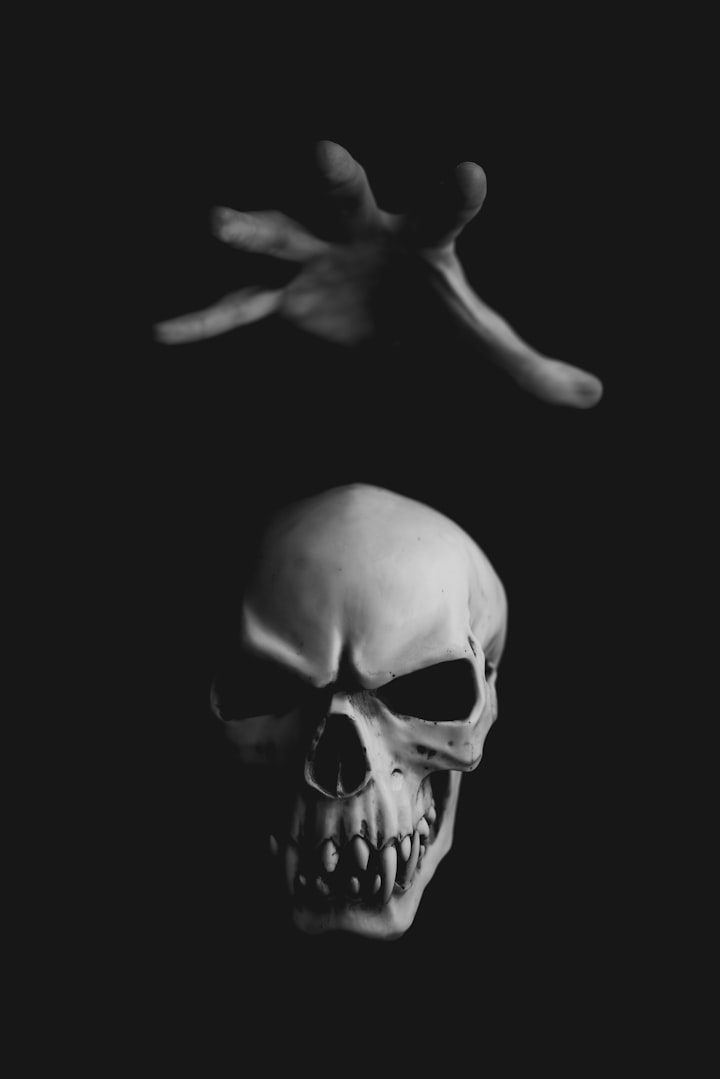

Comments
There are no comments for this story
Be the first to respond and start the conversation.